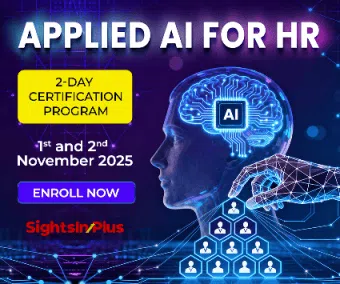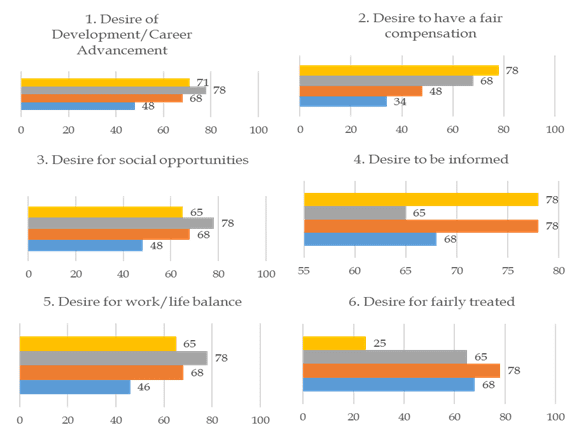Employee retention can be defined as the overall strategy or ability of an organisation to retain its best employees and hence maintain a lower turnover. An organisation is able to achieve this by adopting various employee retention programs. Employee retention is and should be one of the main focus areas of the human resources department in any organization.
An employee retention program involves steps starting from identifying the major contributors in the organisation, and designing schemes to involve them with the organisation to ensure that they do not leave.
In general, typical retention strategy includes:
- Better Job Design to motivate and engage the employee.
- Good compensation so that the employee does not look for better paying opportunities outside.
- On job learning and training helps the employee to remain relevant, add to the skills, and contribute back to the organization
- Better perks like insurance, car, house etc. which makes sure that employee feels comfortable and secure.
- Rewards and Recognition go long way in valuing the employee and making sure that he/she stays.
- Inclusion in company decisions will give employee the confidence of being an important part of the company.
- Timely interaction with the employees to make sure they are not dissatisfied with the job or role so that steps can be taken to improve the situation.
- In case employee decides to leave, proper channel and process should be in place to make sure company can communicate options and listen to the reasons so that employee can take a more informed decision.
The strategy for retention differs from employee to employee, organization to organization, industry to industry and various such factors. For any strategy to work for we need to have a reliable data and a valid model (which can be build using predictive modeling tools). The data can come from various sources like psychometric analysis of employees, employee satisfaction survey, pulse report and many others. All such data sets gives a more or less similar picture if the process is done carefully.
This articles revolves around developing a strategy for retention using the employee satisfaction scorecard and getting the trigger points from analysis of previously done exit interview.
Let’s assume for the analysis of previously conducted exit interviews gives following trigger points:
- Desire of Development/Career Advancement – Constantly looking for opportunities to learn new skills or opportunities for increasing self-abilities and also to have an opportunities to expand one’s careers or responsibilities
- Desire to have a fair compensated– The desire to have an equally paid for the job performed and be compensated well.
- Desire of social opportunities – The desire to have a sense of camaraderie in the workplace, intimacy they find, or feeling to be themselves and feel organization as a community and family.
- Desire to be informed – The desire to be aware of what’s happening in the organization and get information or feedback related to work freely.
- Desire of work/life balance – The desire to have emotionally and physiologically better place to work apart from having opportunities to have sufficient time for rest, meeting emergency requirements etc.
- Desire for fairly treated – The desire to be treated as an human and opportunities to be heard if not properly treated in any case.
Data Gathered form Employee Satisfaction Scorecard of individual employee can be segregated under various heads as stated above. The above heads can have data from question form the employee satisfaction survey like.
- Desire of Development/Career Advancement
- I am offered training or development to further myself professionally.
- I think management does a good job of developing managers for leadership positions.
- I am motivated to join courses outside the purview of job assigned to me.
- I think promotions go to those who best deserve them
2. Desire to have a fair compensation
- I feel I receive a fair share of the profits made by this organization.
- Performance of employees here is fairly evaluated.
- People here are paid fairly for the work they do.
- Everyone has an opportunity to get special recognition.
3. Desire for social opportunities
- We’re all in this together
- There is a “family” or “team” feeling here.
- People celebrate special events around here.
- I am able to take time off from work when I think it’s necessary.
4. Desire to be informed
- Management involves people in decisions that affect their jobs or work environment.
- I can ask management any reasonable question and get a straight answer.
- When I look at what we accomplish, I feel a sense of pride.
- Management makes its expectations clear.
5. Desire for work/life balance
- People are encouraged to balance their work life and their personal life.
- I am able to take time off from work when I think it’s necessary.
- This is a psychologically and emotionally healthy place to work.
- People look forward to coming to work here.
6. Desire for fairly treated
- I am treated as a full member here regardless of my position.
- Management shows a sincere interest in me as a person, not just an employee.
- If I am unfairly treated, I believe I’ll be given a fair hearing if I appeal.
- When you join the organization, you are made to feel welcome.
Let’s take case to understand how the strategy can be mapped.
For a set employee, the Employee Satisfaction Survey gives the following information:
Employee A
Employee B
Analysing the above data sets, following preliminary inferences can be brought out
For Employee A, following areas are of critical concern:
1b, 2d, 4c, 5a, 6a and 6d
For Employee B, following areas are of critical concern:
6a
For Employee A, following areas are of high concern:
1c, 2a, 2c, 3d, 4d, 5b, 5d
For Employee A, following areas are of high concern:
1d, 2c, 3d, 5d
Employee A is highly focused on moving up on the corporate ladder and looks for the opportunity for same, and also he/she is not feeling that sufficient opportunity is available. The likability of employee leaving the organization is very high. Counseling session to provide his career growth need to be done.
Employee B is concerned as he/she feels that he is not being treated as a full member of the organization and as since he is feeling isolated, he/she may leave the organization soon. This concern needs to be addressed at the earliest to retain the employee B.
Similarly, other critical concerns evident from the data needs to be addressed at the earliest to retain the employees A and B.
The strategy to be adopted need to be statistically checked to find the correlation between the triggers and the response. For organization wise strategy cluster analysis can be done to find the optimum strategy for retention.
The model devised above is on hypothetical data and may differ from organization to organization. Analytical tools can be used to check the hypothesis of the model and check the predictability. Previous data available will be of great help to confirm the model’s predictability.





